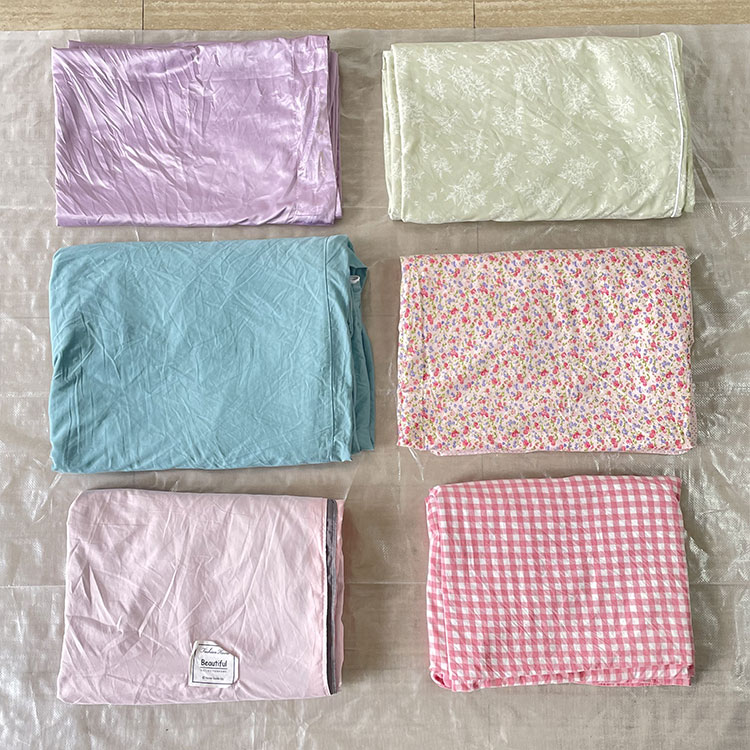Used Bedding: Understanding the Benefits, Considerations, and Proper Disposal
2025-05-07
Used bedding refers to items such as mattresses, pillows, blankets, sheets, and comforters that have been previously owned and used. While bedding is an essential part of our daily lives, the topic of used bedding can be somewhat controversial due to concerns about hygiene, wear and tear, and environmental impact. However, there are various factors to consider when it comes to purchasing, donating, or disposing of used bedding. This article will explore the benefits, considerations, and proper disposal methods of used bedding.

The Benefits of Used Bedding
1. Affordability: One of the main advantages of purchasing used bedding is the cost savings. Secondhand bedding, especially items like mattresses and comforters, are typically sold at a fraction of the price of new ones. For individuals on a budget or those setting up a temporary living situation, used bedding offers an affordable alternative without sacrificing comfort.
2. Sustainability: Buying used bedding can be an eco-friendly choice, helping to reduce waste. By purchasing secondhand items or donating old bedding, individuals contribute to the circular economy by reusing and repurposing products instead of sending them to landfills. This is especially important in a world that is increasingly concerned with sustainability and minimizing waste.
3. Repurposing: Used bedding, especially sheets and blankets, can be repurposed for various creative uses. Old sheets can be transformed into cleaning rags, quilts, or even fabric for craft projects. This extends the life of the material and prevents it from ending up as waste.
Considerations When Buying Used Bedding
While used bedding can be an affordable and sustainable option, there are several important factors to consider to ensure that the items are safe and in good condition.
1. Hygiene: One of the primary concerns when purchasing used bedding is hygiene. Mattresses and pillows, in particular, can harbor dust mites, bed bugs, bacteria, and other allergens. It is important to carefully inspect the bedding before purchasing or accepting it. For mattresses and pillows, it's recommended to check for stains, odors, and signs of damage. If purchasing used bedding online, ensure that the seller provides a clear description of the item’s condition and cleanliness.
2. Wear and Tear: Over time, bedding naturally undergoes wear and tear. Mattresses may lose their shape or support, and comforters and pillows can become flattened or threadbare. If buying used bedding, be sure to inspect it for any visible damage, such as rips, tears, or excessive wear. These issues may affect the comfort and quality of sleep, so it's crucial to assess whether the item still meets your needs.
3. Odor: Used bedding, especially items like mattresses or comforters, may have lingering odors from previous owners, such as body odors or smells from pets. Before purchasing or accepting used bedding, make sure it has been thoroughly cleaned, and if necessary, consider using deodorizers or washing the bedding before use.
4. Allergies and Sensitivities: If you suffer from allergies or have sensitive skin, it's essential to be cautious when buying or using used bedding. Secondhand items might retain dust, pollen, or pet dander from previous owners, which could exacerbate allergy symptoms. Always ensure that the used bedding has been cleaned thoroughly and consider using allergen-resistant covers or pillows to protect your health.
How to Properly Dispose of Used Bedding
If you're ready to part with old or used bedding, there are several responsible ways to dispose of it:
1. Donation: If the bedding is still in good condition, consider donating it to a local shelter, charity, or thrift store. Many organizations accept gently used bedding and distribute it to people in need, such as those experiencing homelessness, or families in shelters. Make sure the items are clean and free from stains or odors before donating them.
2. Recycling: Some recycling centers accept used bedding, particularly sheets and blankets. These items can be broken down and repurposed for other uses, such as insulation or textile recycling. Be sure to check with your local recycling facility to see if they accept bedding, as not all centers do.
3. Upcycling and Repurposing: As mentioned earlier, old bedding can be repurposed for creative uses. If donating or recycling isn’t an option, consider using the materials for DIY projects, such as making pet beds, turning sheets into tote bags, or creating quilts or home decor items. This is a great way to extend the life of your bedding while reducing waste.
4. Proper Disposal: If the bedding is no longer usable and cannot be repurposed or recycled, it should be disposed of properly. For mattresses and pillows, check with your local waste management facility to see if they offer mattress recycling programs or bulky item pickup services. Avoid simply throwing bedding in the regular trash, as it can contribute to landfill waste.
Conclusion
Used bedding is an affordable, sustainable, and versatile option for many individuals, but it's important to consider hygiene, condition, and proper disposal methods when dealing with secondhand bedding. Whether you're buying, donating, or disposing of old bedding, ensuring that it is clean, safe, and well-maintained will help you make informed choices that benefit both your wallet and the environment. By taking the time to inspect and care for used bedding, you can enjoy the benefits of affordable comfort while minimizing waste and supporting sustainability.


